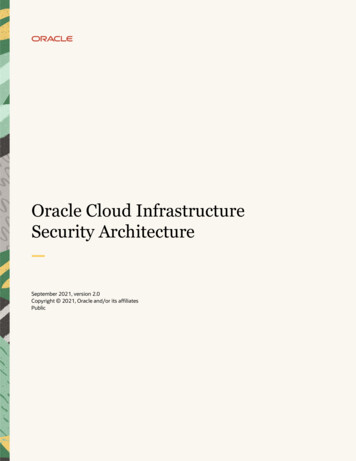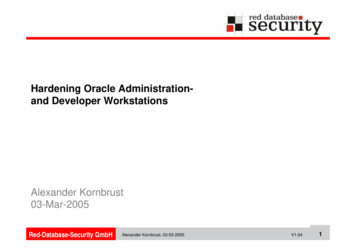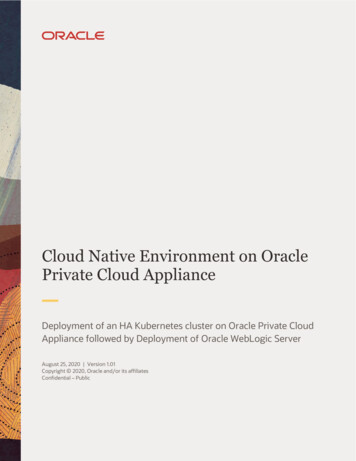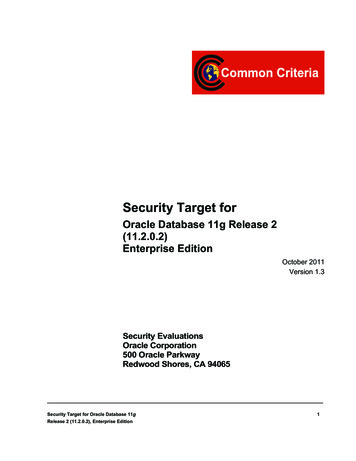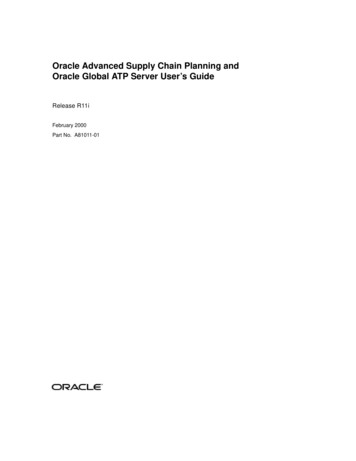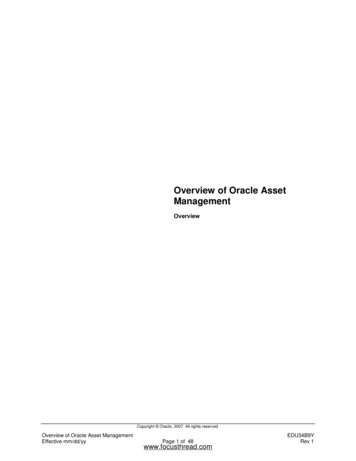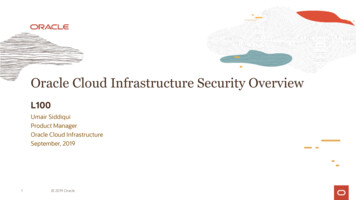
Transcription
Oracle Cloud Infrastructure Security OverviewL100Umair SiddiquiProduct ManagerOracle Cloud InfrastructureSeptember, 20191 2019 Oracle
Safe harbor statementThe following is intended to outline our general product direction. It is intended for informationpurposes only, and may not be incorporated into any contract. It is not a commitment to deliverany material, code, or functionality, and should not be relied upon in making purchasingdecisions.The development, release, timing, and pricing of any features or functionality described forOracle’s products may change and remains at the sole discretion of Oracle Corporation.2 2019 Oracle
AgendaOCI OverviewShared Security Responsibility ModelSecurity Capabilities at a glanceOCI Security Capabilities Customer Isolation Data Encryption Security Controls Visibility Secure Hybrid Cloud High Availability Verifiably Secure Infrastructure Security Considerations
Shared Security ResponsibilityModel
Shared Responsibility Model in Oracle CloudInfrastructureCustomer DataCUSTOMER(Security inthe Cloud)ORACLE(Security ofthe CloudUser Credentials, other account informationAccount Accessmanagement, ApplicationManagementNetwork and FirewallConfigurationInsecure user access behavior, Strong IAM policies,PatchingClient side EncryptionKey managementSecurity list, Route table, VCN configurationOther Infra Services (LB,WAF, CASB, DDoS protection)Compute, Network, StorageIsolation, IAM FrameworkPhysical SecurityConfidential – Oracle RestrictedProtect Hardware, Software,Networking and Facilitiesthat run Oracle CloudServices
Overview of SecurityCapabilities
The 7 Pillars of a Trusted Enterprise Cloud Platform1Customer IsolationFull isolation from other tenants and Oracle’s staff, and between a tenant’sworkloads2Data EncryptionMeet compliance requirements regarding data encryption, cryptographicalgorithms, and key management3Security ControlsEffective and easy-to-use security management to constrain access andsegregate operational responsibilities Secure application delivery4VisibilityProvide log data and security analytics for auditing and monitoring actions oncustomer assets5Secure Hybrid CloudEnable customers to use their existing security assets Integrate with onpremise security solutions Support for third-party security solutions6High AvailabilityFault-independent data centers that enable high-availability scale-outarchitectures and are resilient against attacks7Verifiably SecureInfrastructureTransparency about processes and internal security controls Third-partyaudits and certifications Customer pen-testing and vulnerability scanning Jointly demonstrated compliance7
Oracle Cloud Infrastructure Security Capabilities At aGlance1Customer IsolationBare Metal Instance, VM Instance, VCN IAM, Compartments2Data EncryptionDefault Encryption for Storage, Key Management, DB Encryption3Security ControlsUser Authentication and Authorization, Instance Principals, Network SecurityControl, Web Access Firewall4VisibilityAudit Logs, CASB Based monitoring and enforcement5Secure Hybrid CloudIdentity Federation Third Party Security Solution, IPSEC VPN, Fast Connect6High AvailabilityFault-independent data center, Fault Domain, SLA7Verifiably SecureInfrastructureSecurity Operations, Compliance Certification and Attestation, Customerpenetration and Vulnerability testing8
Customerisolation
Tenant and Resource level isolationComputeI want to isolate my cloudresources from other tenants,Oracle staff, and external threatactors, so we can meet oursecurity and compliancerequirements.I want to isolate differentdepartments from each other, sovisibility and access to resourcescan be compartmentalized.NetworkDataBack-end InfrastructureIdentity and Access ManagementConfidential – OracleInternal/Restricted/Highly Restricted
ComputeBare Metal (BM)Virtual Machine (VM)Direct Hardware Access – customers get the fullBare Metal server(single-tenant model)A hypervisor to virtualize the underlying Bare Metalserver into smaller VMs(multi-tenant model)VMsHypervisorBare Metal ServerBare Metal ServerVM compute instances runs on the same hardware as a Bare Metal instances, leveraging thesame cloud-optimized hardware, firmware, software stack, and networking infrastructure
Off-box Network Virtualization Moves management and IO out of the hypervisor Highly configurable private overlay uestGuestGuestOSOSOSHypervisorHypervisorHost OS/KernelHost OS/KernelIsolated NetworkVirtualizationIsolated NetworkVirtualizationIsolated NetworkVirtualizationSecurity PreventsLateral Movement
VCN and subnets Each customer’s traffic is completely isolated in a private L3 overlay network Network segmentation is done via subnets Private subnets: No internet access Public subnets: Instances have public IP addresses Customers can control VCN traffic VCN stateful and stateless security lists Route table rules Customers can use a Service Gateway that provides a path for privatenetwork traffic between a VCN and a public Oracle Cloud Infrastructureservice such as Object Storage Customers can use VCN peering for securely connecting multiple VCNswithout routing the traffic over the internet or through your on-premisesnetwork
VCN and SubnetAVAILABILITY DOMAINs – AD1OCI REGIONDestination CIDRRoute Target0.0.0.0/0InternetGatewayFrontend, 10.0.1.0/24SL - l1521RT - FrontendInternetSL - BackendTypeRT - BackendInternetGatewayDestination CIDRRoute Target0.0.0.0/0NAT/ Servicegateway /DRGTypeBackend, 10.0.2.0/24VCN, .0/24ProtocolSourcePortDestPortTCPAll1521AllAll
Data Encryption
Storage Encryption Block Storage and Remote Boot Volumes Volumes and backups encrypted at rest using AES 256-bit key (keys managed by Oracle) Data moving between instance and block volume is transferred over internal and highly securenetwork. in-transit encryption can be enabled (paravirtualized volume attachments.) Object Storage Client-side encryption using customer keysData encrypted with per-object keys managed by OracleAll traffic to and from Object Storage service encrypted using TLSObject integrity verification File System Storage Encrypted at rest and between backends (NFS servers and storage servers) Data Transfer Service Uses standard Linux dm-crypt and LUKS utilities to encrypt block devices
Data Encryption At Rest and In Transit Oracle manager OR Customer managed keys (KMS)REGION 1REGION 2AD1AD1AD2SecureAD3AD3All Data is Encrypted at Rest17Confidential – Oracle Internal/Restricted/Highly RestrictedAD2
Database Encryption: At rest and in Transit Oracle TDE encryption for DB files and Backups at Rest. Key Store/Wallet for managing master keyFor improved security, you can configure backup encryption for RMAN backup setsNative Oracle Net Services encryption and integrity capabilities for encrypting data in transit Advanced Encryption Standard (AES), DES, 3DES, and RC4 symmetric cryptosystems forprotecting the confidentiality of Oracle Net Services trafficObject StorageNet Services encryption(In transit data)Encrypted atRest using TDEEncryptedDBEncryptedDB backupEncryptedDB backupTDEMaster keyDBaaS instanceEncrypted RMANbackups
Key Management Oracle Key Management provides you with Highly available, durable, and secure key storage. Encrypt your data using keys that youcontrol Centralized key management capabilities (Create/Delete, Disable/Enable, rotate) IAM Policies for Users/Groups and OCI resources Key Life Cycle management FIPS 140-2 Security Level 3 security certification.
Security Control (Authentication)
Identity and Access Management Identity and Access Management (IAM) service enables you to control whattype of access a group of users have and to which specific resources Each OCI resource has a unique, Oracle-assigned identifier called an OracleCloud ID (OCID) IAM uses traditional identity concepts such as Principals, Users, Groups,Policies and introduces a new feature called Compartments
Identity and Access Management upYPolicyA: allow group GroupX to manage all-resources in compartment CompartmentAPolicyB1: allow group GroupY to manage all-resources in compartment e2PolicyB2: allow dynamic-group GroupZ to use buckets in compartment PolicyAObject StorageBucketsVCNComputeInstancesBlockVolumesLoad Object StorageBucketsBalancersPolicyB2
User Authentication (Password, API key, Auth token) Console password to access OCI resources API signing key to access REST APIs API calls protected by asymmetrically signedrequests over TLS 1.2 Only customers have the private key thatcorresponds to the signing public API key 2048-bit RSA key pairRESTAPI SSH key pair to authenticate compute login 2048-bit RSA or DSA, 128-bit ECC Auth tokens Can be use to authenticate with third-party APIsthat do no support Oracle Cloud Infrastructure'ssignature-based authenticationOracle Cloud InfrastructureResources
User Authentication (MFA) Multi-factor authentication is a method of authentication that requires the use ofmore than one factor to verify a user’s identity. First Authentication using Password Second Authentication using Authentication app such as Oracle Mobile Authenticator or GoogleAuthenticator Authentication app must be installed on your mobile device Can be enabled from OCI Console
Instance authentication (Instance Principal) Instances have their own credentials that are provisioned and rotatedautomatically Dynamic Groups allow customers to group instances as principal actors,similar to user groups Membership in a dynamic group is determined by a set of matching rules(example rule: all instances in the HR compartment) Customers can create policies to permit instances in these groups to makeAPI calls against Oracle Cloud Infrastructure services
Security Control (Authorization)
Authorization Tenant – An account provisioned with a top-level “root compartment”Compartment – A logical container to organize and isolate cloud resourcesGroup – A collection of usersDynamic Group – A collection of instancesResource – An Oracle Cloud Infrastructure resource Policy – Specifies who can access which resources and how, via an intuitivepolicy language. Example policies:allow group SuperAdmins to manage groups in tenancyallow dynamic-group FrontEnd to use load-balancers in compartment ProjectA
Compartments Compartment: NetworkInfra Critical network infrastructure centrally managed by networkadmins Resources: top level VCN, Security Lists, Internet Gateways, DRGs Compartment: Dev, Test, Prod Networks Modeled as a separate compartment to easily write policyabout who can use the network Resources: Subnets, Databases, Storage(if shared) Compartment: Projects The resources used by a particular team or project; separated forthe purposes of distributed management Resources: Compute Instances, Databases, Block Volumes, etc. There will be multiple of these, one per team that needs it's ownDevOps environment
Security Control (Resource Access)
Security Lists (VCN and Subnet)Security ListIngress 129/ TCP 80 AllowEgress0/0 TCP All AllowWeb ServerPublic InternetSecurity ListIngress 10.2.2/24 TCP 1521AllowEgress10.2.2/24 TCP 1521AllowDatabaseServerIGWWeb ServerWeb ServerREGIONVCN 10.2/16AVAILABILITY DOMAIN 1PUBLIC TE SUBNET10.2.3.0/24
Web Access Firewall Designed to protect internet-facing web applications Uses a layered approach to protect web applications against cyberattacks Over 250 predefined Open Web Access Security Project (OWASP), application,and compliance-specific rules Administrators can add their own access controls based on geolocation,whitelisted and blacklisted IP addresses, and HTTP URL and Headercharacteristics Bot management provides a more advanced set of challenges, includingJavaScript acceptance, CAPTCHA, device fingerprinting, and humaninteraction algorithms
Web Access Firewall
Visibility
Audit API calls are logged and made available to customersIncludes calls made via the Console, CLI, and SDKs API for listing audit eventsNew events available within 15 minutes. 90 days of history by defaultConfigurable up to 365 days (affects all regions and compartments) Searchable via the Console
Oracle CASB Cloud ServiceCASBs are software that help enterprises enforce security, compliance andgovernance policies for their usage of applications in the cloud.VisibilityVisibility- Enterprise visibility into risk posture of cloud usageCompliance- Out-of-the-box Reporting for audit and compliance to security best practicesThreat Protection- Autonomous threat detection and predictive analytics using Machine LearningData Protection- Data classification and access control for sensitive data in the cloudRemediation and Enterprise Integrations- Autonomous remediation of threats and incidents with enterprise integrationsDataProtectionVisibilityOracle otectionIndustry’s only CASB that offers proactivemonitoring, threat detection andremediation for Oracle SaaS and OCIConfidential – Oracle Restricted
Cloud Access Security Broker for SaaS and IaaSOracle CASB Cloud ServiceAccess Management Data Loss Prevention Compliance VisibilityCOMPUTESTORAGE &DATABASENETWORK &CONTENTDELIVERYCloud Infrastructure36SECURITY,IDENTITY &COMPLIANCE
CASB Cloud Service for OCI Policy Alerts Alerting and Notifications on policy changes toresourcesPolicy Alerts Security ControlsSecurity Controls Threat DetectionThreat Detection Detection of insecure settings of OCI resources Detection of user risks and threats using MLanalyticsSecurity Reports Key Security Indicator Reports Report generation for key security indicatorsEnterprise Integrations Exporting Data and Threat Remediation Enterprise Integrations with SIEM or ITSM systemsOracle Confidential – Internal/Restricted/HighlyRestricted37
Oracle CASB Monitoring for OCI Performs OCI resource securityconfiguration checks Uses OCI Audit logs and OCI APIs Customers creates a scoped-down OCIIAM user for CASB IAM user behavior analysis ML based anomaly detection in userlogin behavior IP reputation analysis Integration with 3rd party IP reputationfeeds
Examples of CASB OCI Security Checks
Secure HybridCloud
Hybrid SupportIDCSCloud ServicesManagecredentialsfor cloudand datacentersKeyManagementvia ernetIntelligence appliedto any endpointOracle WAF policiesuniqueper domain,per app for cloudand datacenters41
Cross Cloud SupportCloud Provider BCASBCloud ServicesCan managecredentialscross cloudAuthoritativeDNSwithInternetIntelligence canApply cross cloudOracle WAF policiescan be uniqueper domain,per app, per cloudCloud Provider C42
Fast Connect and IPSEC VPNFastConnectWith multiple security optionsOCI REGIONVirtual Cloud withInternetIntelligenceAD1IGWAD2Secure VPNAD343WAF on
Support for Existing Customer Security Assets Identity Federation SAML 2.0 Federation via IDCS and Microsoft Active Directory Federation Service(ADFS) and any SAML 2.0 compliance identity provider Oracle is collaborating with various third-party security vendors to maketheir solutions accessible on Oracle Cloud Infrastructure to enablecustomers to use their existing security tools when securing data andapplications in the cloud See the Oracle Cloud Marketplace for a list of partners who have beensuccessfully tested on Oracle Cloud Infrastructure
Customer Penetration and Vulnerability Testing Customers can perform penetration and vulnerability testing on CustomerComponents such as VMs Customers can schedule Penetration and Vulnerability testing via “MyServices” dashboard.
High Availability
14 RegionsRedundancy and DDoS Protections Distinct geosecurity profilesProtecting Enterprises for More than 40 Years Automatedglobal URICHSEOULASHBURNMUMBAICommercialGovernmentPlanned CommercialPlanned GovernmentEdge Points of PresencePlanned Edge Points ofPresence47TOKYOOSAKASAO PAULOSYDNEY 2000 cloudsecuritypersonnel 24/7 monitoring Trillions ofsignals collecteddaily Internet andCloudIntelligence47
Availability Domains (ADs):Multiple Fault-Decorrelated Independent Data Centers Fault-independentavailability Remote disasterrecovery Predictable low latencyand high speed,encrypted interconnectbetween ADs48Region 1Region 3AvailabilityDomain 1AvailbilityDomain 1AvailabilityDomain 2AvailabilityDomain 3Region 2AvailabilityDomain 1AvailabilityDomain 2AvailabilityDomain 3
Availability Domains (ADs):Multiple Fault-Decorrelated Independent Data CentersEnable you to distribute your compute instances so that they are not on the samephysical hardware within a single Availability Domain Region 1Region 3AvailbilityDomain 1AvailabilityDomain 2AvailabilityDomain 1AvailabilityDomain 3Region 2AvailabilityDomain 1AvailabilityDomain 249AvailabilityDomain 3
Fault Domain(FDs): Enable you to distribute your compute instances so that they are not on the samephysical hardware within a single Availability Domain50
Verifiably SecureInfrastructure
Third-Party Audit, Certifications and Attestations ISO 27001 Regions: Phoenix (Arizona), Ashburn (Virginia), London (United Kingdom), and Frankfurt (Germany) Services covered: Compute, Block Volumes, Object Storage, Networking, Database, Governance, andLoad Balancing SOC 1, SOC 2 and SOC 3 Regions: Phoenix (Arizona), Ashburn (Virginia), and Frankfurt (Germany) Services covered: Compute, Block Volumes, Object Storage, Networking, Database, Governance, andLoad Balancing PCI DSS Attestation of Compliance Services covered: Compute, Networking, Load Balancing, Block Volumes, Object Storage, ArchiveStorage, File Storage, Data Transfer Service, Database, Exadata, Container Engine for Kubernetes,Registry, FastConnect, and Governance.
Third-Party Audit, Certifications and Attestations HIPAA Attestation Services covered: Compute, Networking, Load Balancing, Block Volumes, Object Storage, ArchiveStorage, File Storage, Data Transfer, Database, Exadata, FastConnect, and Governance Services. Strong security controls to meet GDPR requirements For a complete list of compliance certifications and attestations, ture-compliance/
Meet GDPR Requirements Data breach notification within 24 hours Oracle Services Privacy Policy gives transparency about Oracle’sdata handling as a processorLawfully, Fairly, TransparentlyPurpose LimitationAccuracyIntegrity and Confidentiality Customers data stay in the home region chosen by the customerfor their tenancy. Audit Service logs all calls to the API. Compartments, VCN, and Tagging Object Storage, Block Volume and File Storage services forkeeping accurate copies of customer data and ensuring businesscontinuity. Least privilege access control, data encryption, APIauthentication and MFA via identity federation for integrity andconfidentiality.
Physical Security State-of-the-art “Tier IV Class” facilities in the US and Europe Sufficient redundancy of critical equipment such as power sources in case of a failure orbreakdown Layered approach to physical security Perimeter barriersSite-specific badges and identificationSmart-card based authentication
CASBs are software that help enterprises enforce security, compliance and governance policies for their usage of applications in the cloud. Oracle CASB Cloud Service Visibility Visibility-Enterprise visibility into risk posture of cloud usage Compliance-Out-of-the-box Reporting for audit and compliance to

